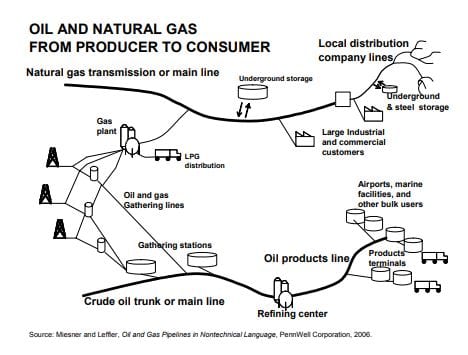Energy from oil and natural gas fuels most of our transportation needs, heats our homes, schools, offices, and shops, and even generates a share of our electricity. Oil and natural gas together supply approximately two-thirds of the U.S. energy needs.
Crude oil and natural gas are generally produced in regions located far from consumption centers. This means crude oil must be moved to refineries, and refined products and natural gas must be moved from producing regions to consumption centers.
The two major types of energy pipelines are:
- Liquids pipelines that transport products such as crude oil or natural gas liquids to refineries for processing and refining. They also transport refined petroleum products like gasoline or jet fuel.
- Natural gas pipelines that transport gas to processing and power plants and are also used to distribute natural gas to our homes and businesses.
Did you know there are four sub-categories of pipelines that each have different functions?
- Gathering lines: Like their name implies, these pipelines gather products from wells and move them short distances to processing plants, where impurities, water, and associated gasses are removed. These pipelines are 10 to 30 centimeters (cm) in diameter.
- Feeder lines: These pipelines are of relatively large diameter (usually 15 to 30 cm) and move crude oil, natural gas, and natural gas liquids from storage tanks and processing facilities to larger transmission pipelines.
- Transmission pipelines: Liquids or natural gas transmission pipelines carry natural gas, natural gas liquids, crude oil, and refined products long distances across the country or to markets in the U.S. They can range from 10 cm in diameter to over a meter.
- Distribution pipelines: These are the pipelines that are generally found around your neighborhood. They bring natural gas to homes and businesses and range in diameter from 1 to 15 cm.
This network of pipelines is the unsung hero supporting our everyday way of life through the movement of water, sewer, crude oil, and petroleum products and natural gas – in many cases tucked under our streets. They safely go through neighborhoods and communities and stretch across farms, forests, deserts, and everywhere in between.


